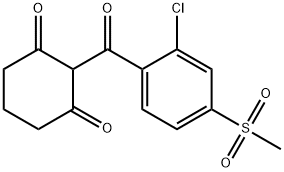Pharmacology
Mode of action studies with sulcotrione first led to the
identity of HPPD as a highly effective herbicide target
site. Early observations showed that a related compound
caused increased levels of tyrosine in the plasma and urine
of treated rats (12). Further studies showed that one of the
tyrosine catabolism enzymes, 4-hydroxypyruvate dioxygenase,
was inhibited by cyclohexanediones (13,14)—this
enzyme being required for the formation of quinones, such
as plastoquinone in plants (12,15,16). Inhibition results in
the perturbation of carotenoid synthesis and inhibition of
photosynthetic electron transport (16).
Metabolism
Sulcotrione is readily absorbed through the leaves and
via the roots. In the soil, metabolism involves ring opening
of the cyclohexanedione, eventually to give the
corresponding benzoic acid (17) and, finally, CO2 (8).
In the soil, the half-life of sulcotrione can vary
considerably (between 15 days in loamy sand and 72 days
in fine loam), depending on a number of factors, especially
the soil organic matter content (18,19).






